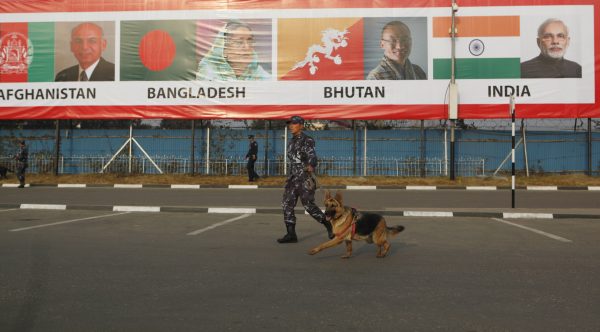
The annual South Asian Association for Regional Cooperation (SAARC) foreign minister’s meeting, which usually happens on the sidelines of the United Nations General Assembly (UNGA) summit in New York, was canceled this year. It is a vital part of SAARC’s engagement mechanism. The annual meeting did not happen last year either, over conflicting views on the Taliban’s participation.
The last SAARC summit, which is supposed to be a biennial event, was hosted by Nepal in 2014. Pakistan was to host the summit in 2016, but it was stalled after India refused to participate following the terror attack in Pulwama in Jammu and Kashmir that New Delhi blamed on Pakistan-based terrorists.
Chatter about SAARC’s death is not new. But SAARC’s inability to have regular meetings has provided further evidence of its demise.
Established in 1985, SAARC had lofty goals: improve quality of life, accelerate economic growth, strengthen collective self-reliance, and contribute to mutual trust, understanding, and appreciation of one another’s problems, among others. However, some principles of SAARC limited its effectiveness. For example, SAARC has to make a unanimous decision and exclude ‘contentious’ issues from the deliberations. This, coupled with the Indo-centric nature of the region and the India-Pakistan rivalry paralyzed the institution from the get-go.
SAARC did make some progress. Five SAARC regional centers that are focused on agriculture, energy, culture, health, and disaster management were established. The South Asian University based in New Delhi was established in 2010. SAARC has also been a critical part of the South Asian regional identity.
However, South Asia is among the least integrated regions in the world. Intra-regional trade accounts for 5 percent of total trade (by comparison, intra-regional trade accounts for 25 percent of ASEAN’s trade). There is hardly any trade of note among the SAARC members other than that with India. For instance, for relatively well-connected Bangladesh, Bangladesh-India trade accounts for 90 percent of Dhaka’s total trade. Its trade with five other countries — Afghanistan, Bhutan, Nepal, Maldives and Sri Lanka — together account for just 2 percent of the country’s total regional trade. It is 20 percent cheaper for India to trade with Brazil, which is on the opposite side of the globe, than with its neighboring countries in South Asia. The South Asian Free Trade Area (SAFTA) has not made a dent.
During the COVID-19 pandemic, SAARC established a COVID-19 Emergency Fund based on voluntary contributions from all SAARC members. Indian Prime Minister Narendra Modi led the way, and members committed a total of $21.6 million. However, the SAARC secretariat has “no knowledge of any progress on the COVID-19 fund. The secretariat does not coordinate and oversee that fund.”
For all practical purposes, SAARC has been defunct since 2014.
Since the terrorist attack in Uri in 2016, the Indian government has pledged to isolate countries supporting terrorism – an apparent reference to Pakistan. As a result, the ruling Bharatiya Janata Party in its election manifesto in 2019 did not include SAARC as a forum for regional cooperation. Instead, the manifesto said, “to forward our ‘neighborhood first’ policy, we will extensively leverage forums such as BIMSTEC [Bay of Bengal Initiative for Multi-Sectoral and Economic Cooperation], to accelerate regional coordination and economic cooperation with countries in our neighborhood.”
With this, India made clear its disinterest in SAARC, and thus indirectly announced its veritable death. Unsurprisingly, India’s arch-rival, Pakistan, is not a member of BIMSTEC.
Sri Lanka and Nepal have been pressing for a SAARC summit. Yet, without Indian participation and interest, SAARC cannot move forward. Additionally, the Taliban takeover in Afghanistan has added another layer of indecision among SAARC members. In 2007, Afghanistan under then President Hamid Karzai joined SAARC. Should Afghanistan under the Taliban regime be a part of SAARC?
With the chill in India-Pakistan relations unlikely to thaw soon, India has already pivoted to alternative regional and subregional organizations such as BIMSTEC and the BBIN (Bangladesh, Bhutan, India, Nepal Network).
The South Asian subcontinent has enough common attributes and issues to warrant some regional organization. It has a shared ancient civilization and geographically its focus converges towards the Indian Ocean. The region faces common threats, especially on non-traditional security issues such as climate change, natural disasters, food and energy security, and mass migration. The realized trade is minuscule compared to the trade potential.
These factors indicate a need for a regional body. However, SAARC’s failure suggests the region may not be ready for a political organization. The way forward could be technical associations of subregional groupings based on an interest area such as the BBIN.
For instance, Nepal, India, Bangladesh and Bhutan could have separate mini-lateral collaborative institutions/committees on hydroelectricity cooperation. Similarly, a separate specialized agency could be created to address climate change and cross-border disaster management. Such collaboration could be led by committees within relevant ministries, government-affiliated think tanks, or instituted as a regular forum outside of any ministry. This may not be the optimal solution, but technical collaboration between countries facing common interests (and limited membership) might lead to effective cooperation.
In the long term, should any collaborative forums organically develop to include a larger agenda and a bigger membership, we may see a revival of the SAARC or SAARC-like institution. After all, cooperation on coal and steel led to the emergence of the European Union.
SAARC Is Dead. Long Live Subregional Cooperation
Source: Frappler

0 Comments